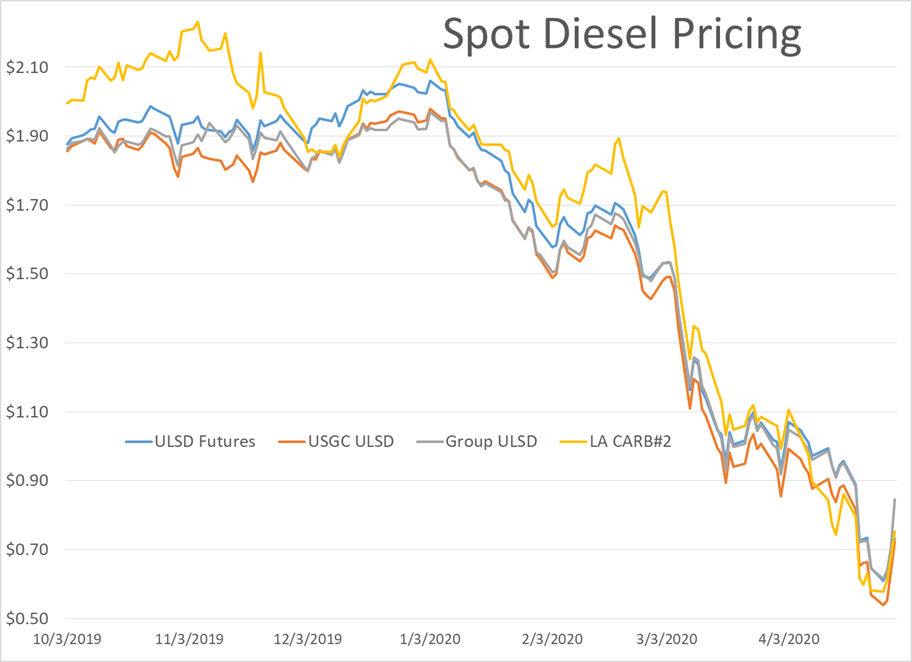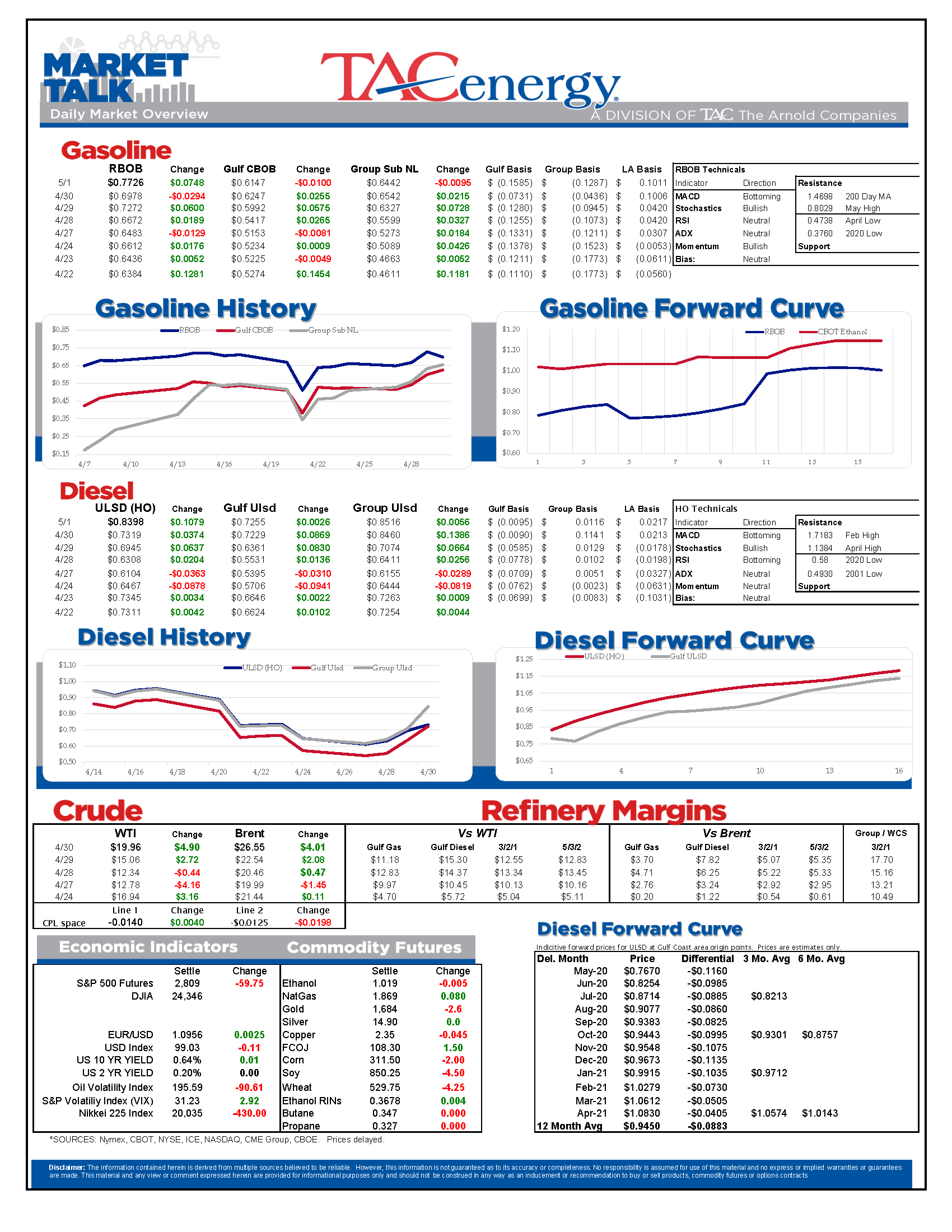Why Are Gasoline Prices Moving Lower Today?

A bumpy and disorganized overnight trading session seems to be a fitting way to start the month of May, as much of the world treads cautiously towards the beginning stages of reopening after six weeks of lock-down. May Day celebrations around the world will keep trading volumes lighter than normal today, adding to the choppy action.
Most energy contracts were selling off overnight only to rally back in the past hour, with June WTI breaking north of the $20 mark for the first time since the Monday melt-down. Refined products are also struggling for direction, with nickel trading ranges in the early going and mixed results across the contracts.
A good lesion in the difference between futures and physical prices: The expiration of the May RBOB and ULSD contracts in the midst of a super contango means the June contracts are trading some seven to 11 cents higher than where May left off, but those values don’t carry over to cash markets which are seeing minimal change so far today. This phenomenon is often misunderstood, and not often talked about since in normal times the calendar spreads in futures are a small fraction of where they are today. Ask anyone who was invested in the U.S. Oil ETF last week if they understand this lesson now.
Small oil companies in the U.S. have been defying the odds for years, outpacing production estimates consistently thanks to new drilling technology. It’s little wonder that these companies are now once again exceeding estimates in their ability to shut-in production faster than expected, which should help alleviate some of the near term storage concerns. There’s a new lifeline for some of these producers as one of several new Federal Reserve lending programs has been opened to the industry this week.
The opposite of a small oil company, ExxonMobil, released earnings this morning, showing a quarterly loss for the first time in years due to a $2.9 billion non-cash write down of inventory values. The statement noted weaker refining margins both in the U.S. and around the world, but its total downstream margins were high thanks to “favorable mark-to-market derivatives and improved manufacturing on lower scheduled maintenance.”
Wondering why May RBOB settled lower Thursday even when prices were higher at the close? Read about the difference in settlement procedures on expiration day here. That will also help explain why gasoline prices are moving lower today, even while a comparison to May’s settlement makes it appear that RBOB futures are sharply higher on the day. April was a month that broke the charts, so it seems fitting to end it with more confusion.
Normal Daily Settlement Procedure
NYMEX RBOB Gasoline (RB) futures are settled by CME Group staff based on trading activity on CME Globex during the settlement period. The settlement period is defined as: 14:28:00 to 14:30:00 ET for the Active Month and 14:28:00 to 14:30:00 ET for calendar spreads.
Final Settlement Calculation for Expiring Contract
On the day of expiration, the expiring month will settle based on the VWAP of the outright CME Globex trades executed between 14:00:00 and 14:30:00 ET.
Click here to download a PDF of today's TACenergy Market Talk.
Latest Posts
Gasoline Futures Are Leading The Way Lower This Morning
The Sell-Off Continues In Energy Markets, RBOB Gasoline Futures Are Now Down Nearly 13 Cents In The Past Two Days
Week 15 - US DOE Inventory Recap
Prices To Lease Space On Colonial’s Main Gasoline Line Continue To Rally This Week
Social Media
News & Views
View All
Gasoline Futures Are Leading The Way Lower This Morning
It was a volatile night for markets around the world as Israel reportedly launched a direct strike against Iran. Many global markets, from equities to currencies to commodities saw big swings as traders initially braced for the worst, then reversed course rapidly once Iran indicated that it was not planning to retaliate. Refined products spiked following the initial reports, with ULSD futures up 11 cents and RBOB up 7 at their highest, only to reverse to losses this morning. Equities saw similar moves in reverse overnight as a flight to safety trade soon gave way to a sigh of relief recovery.
Gasoline futures are leading the way lower this morning, adding to the argument that we may have seen the spring peak in prices a week ago, unless some actual disruption pops up in the coming weeks. The longer term up-trend is still intact and sets a near-term target to the downside roughly 9 cents below current values. ULSD meanwhile is just a nickel away from setting new lows for the year, which would open up a technical trap door for prices to slide another 30 cents as we move towards summer.
A Reuters report this morning suggests that the EPA is ready to announce another temporary waiver of smog-prevention rules that will allow E15 sales this summer as political winds continue to prove stronger than any legitimate environmental agenda. RIN prices had stabilized around 45 cents/RIN for D4 and D6 credits this week and are already trading a penny lower following this report.
Delek’s Big Spring refinery reported maintenance on an FCC unit that would require 3 days of work. That facility, along with several others across TX, have had numerous issues ever since the deep freeze events in 2021 and 2024 did widespread damage. Meanwhile, overnight storms across the Midwest caused at least one terminal to be knocked offline in the St. Louis area, but so far no refinery upsets have been reported.
Meanwhile, in Russia: Refiners are apparently installing anti-drone nets to protect their facilities since apparently their sling shots stopped working.
Click here to download a PDF of today's TACenergy Market Talk.

The Sell-Off Continues In Energy Markets, RBOB Gasoline Futures Are Now Down Nearly 13 Cents In The Past Two Days
The sell-off continues in energy markets. RBOB gasoline futures are now down nearly 13 cents in the past two days, and have fallen 16 cents from a week ago, leading to questions about whether or not we’ve seen the seasonal peak in gasoline prices. ULSD futures are also coming under heavy selling pressure, dropping 15 cents so far this week and are trading at their lowest level since January 3rd.
The drop on the weekly chart certainly takes away the upside momentum for gasoline that still favored a run at the $3 mark just a few days ago, but the longer term up-trend that helped propel a 90-cent increase since mid-December is still intact as long as prices stay above the $2.60 mark for the next week. If diesel prices break below $2.50 there’s a strong possibility that we see another 30 cent price drop in the next couple of weeks.
An unwind of long positions after Iran’s attack on Israel was swatted out of the sky without further escalation (so far anyway) and reports that Russia is resuming refinery runs, both seeming to be contributing factors to the sharp pullback in prices.
Along with the uncertainty about where the next attacks may or may not occur, and if they will have any meaningful impact on supply, come no shortage of rumors about potential SPR releases or how OPEC might respond to the crisis. The only thing that’s certain at this point, is that there’s much more spare capacity for both oil production and refining now than there was 2 years ago, which seems to be helping keep a lid on prices despite so much tension.
In addition, for those that remember the chaos in oil markets 50 years ago sparked by similar events in and around Israel, read this note from the NY Times on why things are different this time around.
The DOE’s weekly status report was largely ignored in the midst of the big sell-off Wednesday, with few noteworthy items in the report.
Diesel demand did see a strong recovery from last week’s throwaway figure that proves the vulnerability of the weekly estimates, particularly the week after a holiday, but that did nothing to slow the sell-off in ULSD futures.
Perhaps the biggest next of the week was that the agency made its seasonal changes to nameplate refining capacity as facilities emerged from their spring maintenance.
PADD 2 saw an increase of 36mb/day, and PADD 3 increased by 72mb/day, both of which set new records for regional capacity. PADD 5 meanwhile continued its slow-motion decline, losing another 30mb/day of capacity as California’s war of attrition against the industry continues. It’s worth noting that given the glacial pace of EIA reporting on the topic, we’re unlikely to see the impact of Rodeo’s conversion in the official numbers until next year.
Speaking of which, if you believe the PADD 5 diesel chart below that suggests the region is running out of the fuel, when in fact there’s an excess in most local markets, you haven’t been paying attention. Gasoline inventories on the West Coast however do appear consistent with reality as less refining output and a lack of resupply options both continue to create headaches for suppliers.



